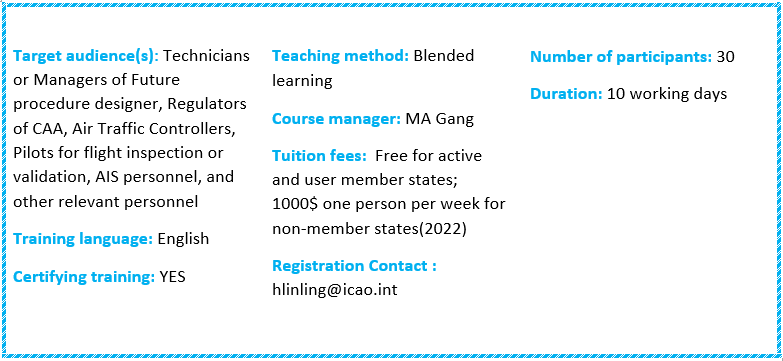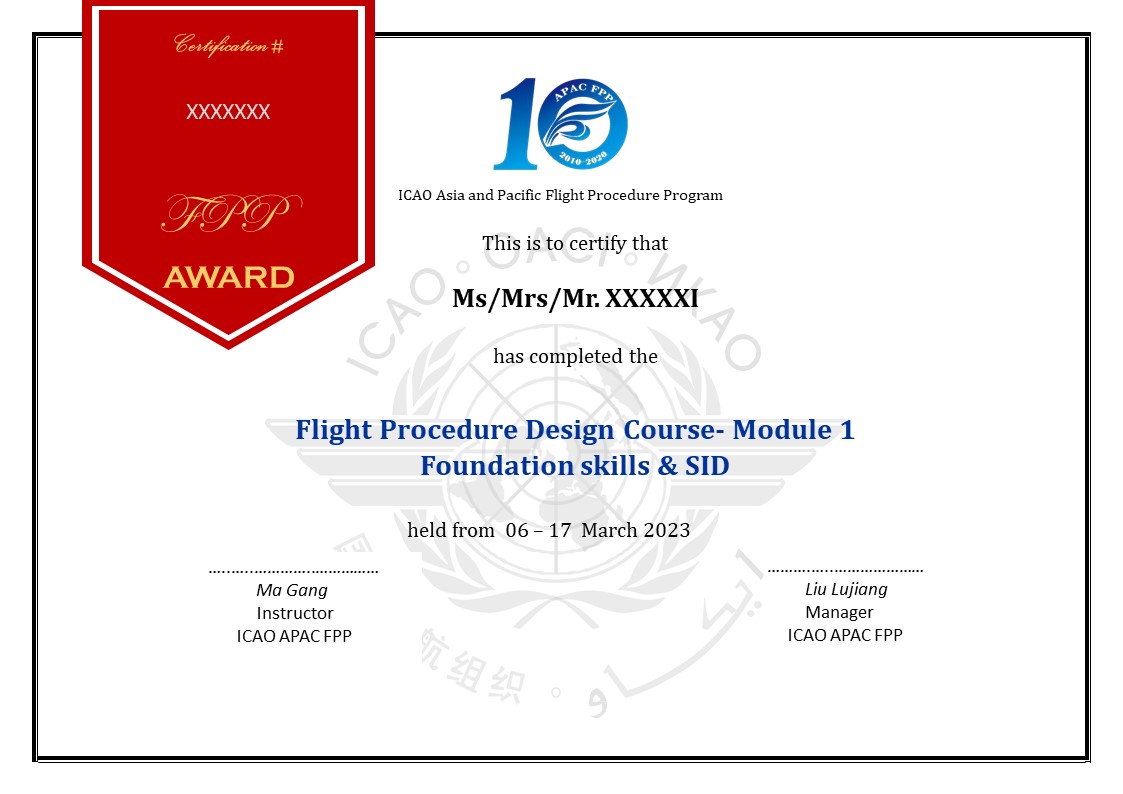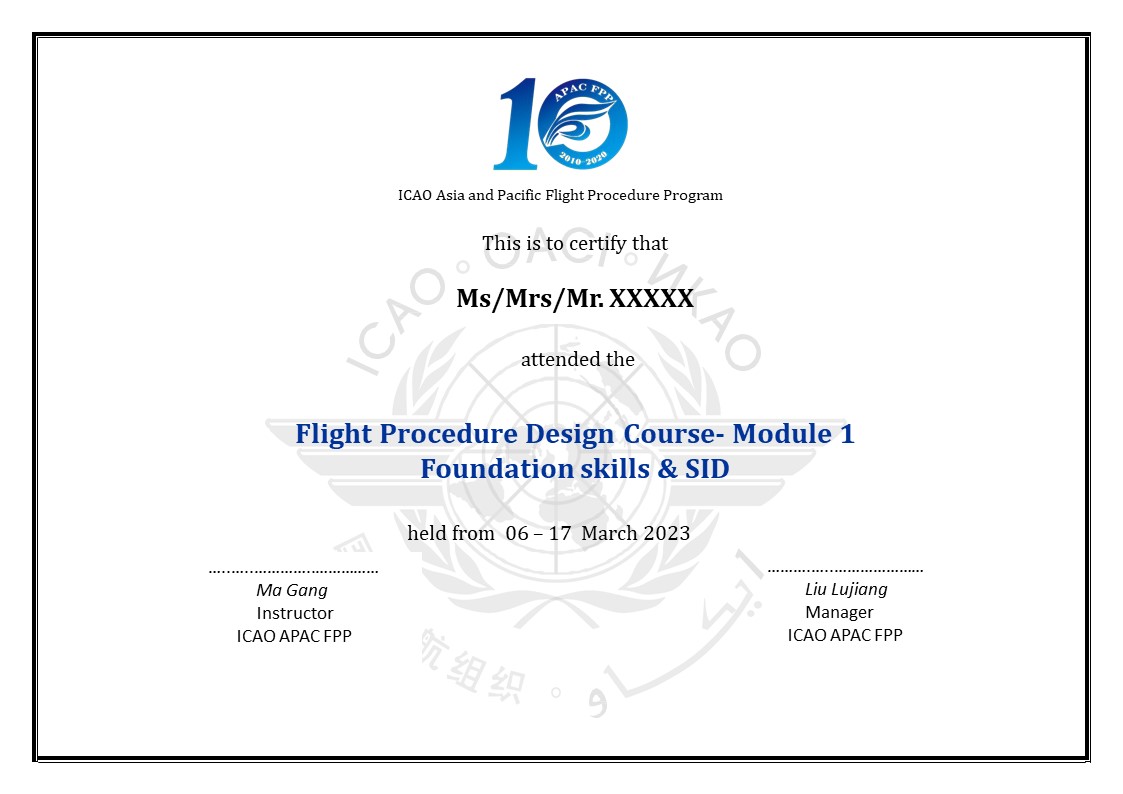
Overview
This course details criteria for the fundamental instrument procedure design and the design of departure procedure for both conventional and PBN navigation.
Objectives
After this training, the participant, as future procedure designer tutored by a senior procedure designer is able to:
- Calculate the turn parameters, draw the bounding circle
- Merge segments of different widths for protection area
- Design or Cross check PBN and conventional departures procedures
- Enable Charting and Coding for PBN departure procedure
Participants concerned
Future procedure designers, Regulators of CAA, Air Traffic Controllers, Pilots for flight inspection or validation, AIS personnel, and other relevant personnel
Prerequisites
Attendees should feel comfortable to communicate in English.
Tuition fees
- Free for Active and User Member States,
- 1000$ one person per week for Non-Member States.
Content
At APAC FPP, according to ICAO doc 9906 volume 2, the initial training of IFR procedures designer consists of three main modules. Each module is independent but completing each other, trainees can choose module on demand. This module is considered the first step in a comprehensive training program to design IFR procedure.
The training is organized around courses, exercises and assessments to apply all the design criteria addressing PBN and conventional departures procedures. The pillars of this training include a case study from ICAO 9368 and a real published procedure.
Focus
- Conventional navigation and PBN navigation concept
- Turn protection areas and connection
- Limitation elements of segments
- Coding for departure procedures
- Publication, procedure design documentation
- Conventional and PBN SID (Standard Instrument Departure)
Theoretical courses
2 weeks' courses are in remote classes.
Presentation and explanation of the rules and principles described in Doc 8168-OPS/611.
Exercises
Elementary use of the regulation concepts in a simplified environment, conducted to enforce the theoretical input.
Exercises are daily scheduled.
The exercises about departure criteria are in remote classes.
Course rundown
| Topic | Module | Further Description |
| What is Flight Procedure Design | 1
| Main task for FPD, MOC and MOCA. |
| ICAO Documents | 1 | DOC 8168,PBN manual, DOC9906 |
| The IFP Process | 1 | Quality Assurance Process of IFP |
| Unit Conversions | 1 | Conversions between SI Units and non-Si units |
| IAS to TAS | 1 | Conversions from IAS (used by pilot) to True Air Speed (used for FPD) |
| Segments on an NPA | 1 | Segments in NPA |
| Fixes Tolerance and Semi-Width | 1 | Tolerance of DME Fix, over a facility and PBN waypoints, the semi-width/protection areas of different cases. |
| Turn Calculations | 1 | Calculations of Rate of turn and radius of turn. |
| Turn Protection | 1 | Protection areas of the turn based on Wind effect and Bounding circles. The method about 'inner side' and 'outside' that must be used in the different cases of the merging between the turn and the segments. |
| Aircraft Categories | 1 | Categorization of Aircraft |
| Charting/AIP | 1 | Charting requirements, published information for SID |
| Departures | 1 | Conventional and PBN departures. Obstacle assessment, PDG calculation. |
| PBN concept | 1 | ICAO PBN Concept. Navigation Specifications |
| Navigation Sensors in PBN | 1 | GNSS, DMEDME, VORDME, SBAS,GBAS |
| ARINC 424 Path/Terminators | 1 | ARNINC 424 coding issues for PBN SID |
| PBN Departures | 1 | Including in the Departures part, contrast with conventional SIDs. |
Project
Design of departure procedures in a geographic and aeronautic realistic environment. The design is carried out step by step under the guidance of instructors. The project includes also the design of SID Chart and appropriate documentation.
Assessment
Several progress tests are carried out to identify the trainee's ability to apply procedure design criteria. Correction of the project is part of the assessment.
At the end of the course, an individual assessment report is provided to each participant.
Certificate issuance
If participants who do not complete the daily practice (homework) during the two weeks of training will automatically lose the chance to attend the final tests.
The final tests can only be taken twice. The pass mark is 60. APAC FPP offers any students with a fail grade to re-take the test. If a participant scores below 80 on both tests, the overall grade of the course will be a fail. If participants who can only take the test once for their personal reasons will automatically lose a chance, we will not provide an opportunity for individual make-up test.
Those who successfully complete and pass the test will be awarded the qualification certificate as below.

APAC FPP can only issue the attending training certificate without the certificate number to those who fail the tests twice.

Assistance
Contact with referent instructor (s) is provided throughout the course.
Delivered course material
Courseware will be uploaded to APAC FPP website.
